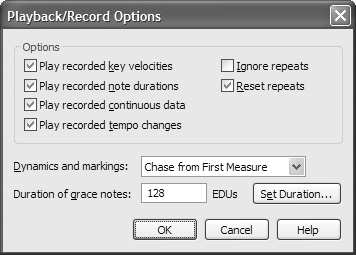|
L'aide française est disponible au format PDF en cliquant ici (ou dans le Menu "Démarrer", Finale 2010, Documentation PDF française)
Le tutoriel français est disponible au format PDF en cliquant ici.
La mise à jour de l'aide française au format HTML sera disponible prochainement.
|
Traduction française :

|
The MIDI Tool 

If you want precise control over every aspect of the MIDI data, you can use the MIDI Tool instead of applying Human Playback. The MIDI Tool lets you edit the raw MIDI data of your score, from a single note to an entire staff. You can visually edit pitch bends, velocity, patch changes, and other parameters. If Human Playback provides all the control you desire over your performance, you can skip the rest of this chapter.
Captured MIDI information isn’t really part of the notation itself. Instead, it consists of variables that a musician creates in a performance of the music—specifically, when recording with HyperScribe. Stress and accents, rushing the beat—all of these human elements constitute captured MIDI data. When you use Human Playback, this data is added for you temporarily every time you play back the score. The MIDI Tool allows you to adjust this data for your score manually.
In Tutorial 1c you experimented with the scrolling playback option; at the end of the tutorial, you listened to the original performance of a piece while looking at the notated version. Finale always lets you choose which way you’d like to hear your music: as strict, perfectly even sheet music, or as the original, unquantized MIDI performance, with a human feel and all captured MIDI data intact.
As an experiment, try listening to the same piece twice—once with, and once without the captured MIDI data.
- Close the open document, if you want. Open the document called “Tutorial 6a.” The document—a passage from Ellmenreich’s “Spinning Song”—appears.
- For the remainder of this chapter, you will be applying MIDI data manually. Since Human Playback is set (by default) to override all MIDI Tool data, so before continuing, we’ll need to ‘turn off’ Human Playback:
- From the MIDI/Audio menu, choose Human Playback, and select None. The Playback Settings appear. Now, Finale will not process the entire score for Human Playback each time you playback your score. (You can still use the Apply Human Playback plug-in to ‘activate’ Human Playback for regions of your score).
- While pressing the Space bar, click the first measure. The piece plays back—technically perfect, but without any expression (other than the dynamic markings that are defined for playback, etc.).
For comparison, listen to it now as it was originally performed. To tell Finale to use the captured MIDI data, you have to change some settings in the Playback/Record Options dialog box. To prepare for the MIDI Tool lesson, do the following:
- From the Document menu, choose Playback/Record Options. The Playback/Record Options dialog box appears.

- Select all four “Play” checkboxes in the upper-left corner of the dialog box. Now listen to the difference when Finale uses the captured performance data.
- Click OK; then spacebar-click the first measure. Finale plays back the score as it was recorded in HyperScribe. For example, you should hear a natural crescendo in the first two measures (that is, if your keyboard is touch-sensitive). Finale is using the performance data captured from an actual performance. Click the mouse if you want to interrupt the playback.
 Previous Previous
|
Next  |




